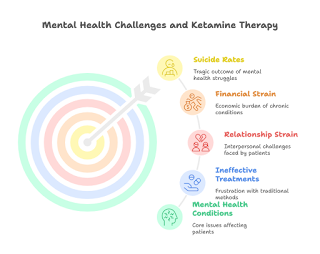Ketamine Therapy: A Comprehensive Guide to Uses, Benefits, and Risks
Introduction
Attention (Hook)
Imagine waking up from a single treatment feeling lighter, more transparent, and more hopeful than you have in years—without waiting weeks for results. It's the reality of ketamine therapy, a groundbreaking treatment rapidly transforming mental health care.
Problem (Agitate the Pain)
For decades, millions suffering from treatment-resistant depression (TRD), PTSD, chronic pain, and anxiety disorders have endured a frustrating cycle of ineffective medications, therapy, and hospital visits. Traditional antidepressants like SSRIs can take 4-6 weeks to work, assuming they work at all. Meanwhile, the emotional and financial toll grows—lost jobs, strained relationships, and, tragically, rising suicide rates.
Promise (Solution & Hope)
Ketamine therapy offers a fast-acting, scientifically validated alternative for those who've lost hope. In this 3,500-word guide, we'll explore:
- How ketamine works in the brain (with clinical studies)
- Which conditions it treats most effectively
- Real-world costs, insurance coverage, and clinic options
- Safety concerns, side effects, and long-term risks
- Patient success stories and emerging research
By the end, you'll know whether ketamine therapy could be right for you or a loved one.
1. What Is Ketamine Therapy?
From Anesthetic to Mental Health Breakthrough
Originally developed as an anesthetic in the 1960s, ketamine gained FDA approval for medical use due to its safety and rapid effects. By the early 2000s, researchers discovered its unexpected antidepressant properties, leading to its off-label use for mental health disorders.
How Ketamine Works in the Brain
Unlike SSRIs (which target serotonin), ketamine works on the NMDA receptors, boosting glutamate production—a neurotransmitter linked to neuroplasticity (the brain's ability to rewire itself).
- Rapid Relief: Many patients report mood improvements within hours.
- Sustained Effects: Some studies show benefits lasting weeks after treatment (Zarate et al., 2006).
Administration Methods
| Method | Usage | FDA-Approved? |
|---|---|---|
| IV Infusion | The gold standard for TRD | Off-label |
| Nasal Spray (Spravato) | FDA-approved for TRD & MDD | Yes |
| Oral Lozenges | At-home use (monitored) | Off-label |
Related: Ketamine vs. Traditional Antidepressants: Which Works Faster?
2. Conditions Treated by Ketamine Therapy
1. Treatment-Resistant Depression (TRD)
- 60-70% of TRD patients respond to ketamine when SSRIs fail (Murrough et al., 2013).
- Suicide Risk Reduction: A 2020 study found 50% lower suicidal thoughts post-infusion.
2. PTSD and Anxiety Disorders
- Veterans and trauma survivors show reduced flashbacks and hypervigilance (Feder et al., 2014).
3. Chronic Pain Syndromes
- Effective for fibromyalgia, CRPS, and migraines by blocking pain signals.
Related: Can Ketamine Replace Opioids for Chronic Pain?
3. Benefits of Ketamine Therapy
1. Speed of Action
- Hours vs. Weeks: SSRIs typically take 4-6 weeks; ketamine often starts working within 24 hours.
2. High Success Rate
- A 70% response rate in TRD patients compared to 30% for SSRIs.
3. Neuroplasticity Boost
- Helps the brain form new, healthier neural pathways.
4. Ketamine Therapy Cost & Accessibility (2024)
Pricing Breakdown
| Treatment Type | Average Cost per Session | Total Cost (6-Session Protocol) |
|---|---|---|
| IV Ketamine | $400–$800 | $2,400–$4,800 |
| Spravato (Nasal) | $600–$900 (with insurance) | Covered by some insurers |
Insurance Coverage
- Spravato is FDA-approved, so Medicare and private insurers often cover it.
- IV ketamine is rarely covered (considered off-label).
Related: How to Find Affordable Ketamine Therapy
5. Risks and Side Effects
Short-Term Side Effects
- Dissociation (the "K-hole")
- Nausea, dizziness, elevated blood pressure
Long-Term Risks
- Bladder issues (with frequent, high-dose use)
- Dependency potential (rare with clinical use)
Related: Ketamine Therapy: Is It Addictive?
6. Patient Case Studies
Case 1: Sarah's Battle with TRD
"After 15 years of failed meds, ketamine gave me my life back in 3 sessions."
Case 2: Veteran with PTSD
"Ketamine reduced my nightmares when nothing else worked."
7. FAQs About Ketamine Therapy
Q: Is ketamine therapy FDA-approved?
A: Only Spravato (esketamine nasal spray) is FDA-approved for TRD. IV ketamine is off-label but legal.
Q: How long do effects last?
A: 2-4 weeks for depression.
8. Conclusion & Next Steps
Ketamine therapy isn't a miracle cure—but for many, it's the first real hope in years. If you're considering it:
- Consult a psychiatrist; not all clinics are equal.
- Check insurance coverage for Spravato.
- Monitor side effects closely.


%20-%20visual%20selection.png)
